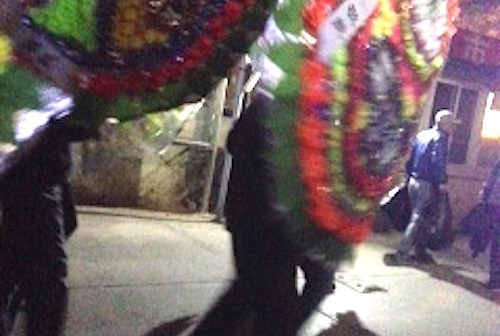The traditional Chinese way to say good-bye to the departed is not something I’m intimately acquainted with. But, in my complex where several families have lived for more than two decades, I have witnessed some fascinating funeral rituals. In the past two weeks, there have been two in the courtyard. While I don’t understand everything, what is loudly conveyed is the importance of a collective farewell from an established community.

I have lived in China for eight years. I also live in an old complex in Lido, a twenty-three year old complex to be exact, that was constructed very early on in the development of outer fourth ring road areas. This was the housing complex given to the people who originally lived on this land in píngfáng (one-story houses). In other words, when this was nóngcūn(countryside), more than seventy percent of the families in my housing complex were working the fields. The remaining thirty percent of the units in this complex are rented out—some to foreign moms like me.
Last week, as I was riding my bicycle into the complex in the early evening after work, I had to pull over to let a funeral procession pass. Large round, circular floral umbrella-like banners were being twirled and lifted into the air. They were decorated with many Chinese characters and those who danced and walked with them did so with a lot of energy and life.
I didn’t want to be disrespectful by photographing something so sacred, but I nevertheless (and very inconspicuously) caught a few images as they were passing in the twilight dim.

These “circular flower” holders were followed by a band of musicians who sounded like they were whacking pots and pans in no particularly rhythmic order. They were carrying large metal bowl-like discs with sticks or hand-held cymbals that they were crashing together.
They marched out of the complex and turned the corner. Later, I realized where they were going: to the patch of earth (a small planned forest) between the airport expressway and Side (四德)park, an area in which burial mounds still exist as they once did in the countryside. This is their traditional gravesite. It has been protected.

The following week, another funeral happened. This time, the family set up a large tent with tables and chairs as well as a yellow inflated archway through which a smaller tent held the departed’s photo displayed alongside of many flowers, like a shrine. They’ve been serving refreshments these past two days to community members. When people walk away from the site, they all have small red flowers pinned to their lapels.

The procession should happen this evening, and as I listen to the clanging and singing, I know I won’t help but feel once again that there’s something so very right about these rituals. They’re a loud farewell, audible from the other side, rather than mournfully solemn, quiet affairs. After all, it’s better to “go out with a bang,” no?
I can only hope these ancestors are aware of how moved their goodbye rituals have made this particular lăowài feel.
Photos: Courtesy of Ember Swift




